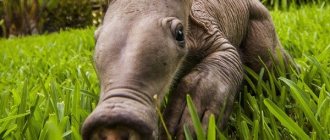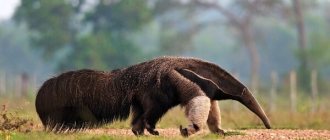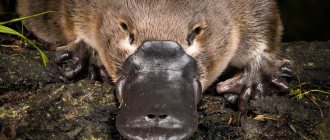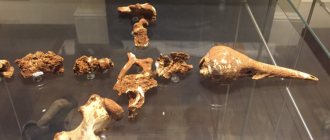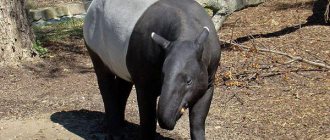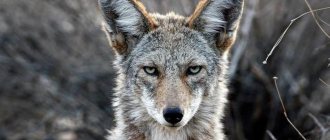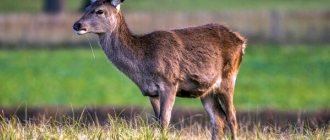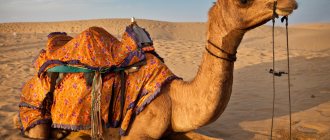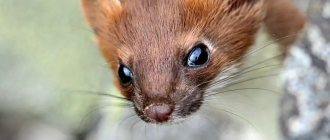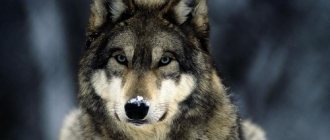Galagos are small, large-eyed primates native to sub-Saharan Africa. Mostly inhabitants of dense humid tropical forests, sometimes they live in savannas. According to the official classification, galago belongs to the family of galago lemurs. Previously, they were classified as a subfamily (Galagonidae) in the Loridae family. Indeed, these animals are very similar to the loris lemurs and are evolutionarily close to them, but the galagids are more ancient, so it would be more correct to classify them as an independent family.
Scientific classification
- Kingdom: Animalia (animals)
- Phylum: Chordata
- Class: Mammalia (mammals)
- Order: Primates (primates)
- Family: Galagidae (galagidae)
- Genus: Galago (galago)
Photo: Primates Park
The taxonomy of the genus is often disputed and revised in the scientific literature; at the moment, scientists identify 14 varieties of galago:
- Allen's galago (Galago alleni);
- Cameroon galago (Galago cameronensis);
- Galago demidoff;
- Gabonese galago (Galago gabonensis);
- Somali galago (Galago gallarum);
- Grant's galago (Galago granti);
- East African galago (Galago matschiei);
- South African galago (Galago moholi);
- Malawian galago (Galago nyasae);
- mountain galago (Galago orinus);
- dwarf galago Rondo (Galago rondoensis);
- Senegalese galago (Galago senegalensis);
- Thomas' galago (Galago thomasi);
- Zanzibar galago (Galago zanzibaricus).
Species are difficult to distinguish from each other based on morphology alone, partly due to convergent evolution. As a result, taxonomy of galago species within a genus is often based on studies of their vocalizations, genetics, and morphology.
Spread range
Geographical distribution
Galagos are found across much of the sub-Saharan African continent, from eastern Senegal to Somalia and all the way to South Africa (except its southern tip), and in almost all central African countries.
Photo: Dean Polley
However, there are large differences in the prevalence of these primates across species. For example, the Demidov's galago and the Senegalese galago have some of the largest home ranges, each found in more than ten countries. At the same time, other species are found only in one country, for example, the mountain galago and the Rondo dwarf galago live only in Tanzania. In addition, some species establish sympatric relationships with other species with significant range overlap.
Home range varies among galago species and ranges from 0.5–50 hectares , with females typically occupying a smaller area than males.
Habitat
Due in part to its wide distribution, the galago adapts to a wide variety of habitats and ecological zones, which often differ greatly in climatic conditions. These primates live in tropical forests, savanna, forest edges, semi-arid areas, coastal scrub, foothills and montane forests at altitudes up to 2800 meters above sea level.
Photo: Africa Geographic
In some habitats, the climate varies depending on the season. The most extreme conditions are found in South Africa, where annual rainfall averages just 610mm and temperatures range from -5 to 38°C throughout the year, varying by as much as 25°C in a single day! The effects of winter cold in such extreme habitats can sometimes be quite severe, causing seasonal weight loss due to food shortages in addition to damage to tails from frostbite.
Nutrition
Galago is an omnivorous animal; feeding it at home will not be difficult. A prerequisite is to combine animal and plant foods. All fruits and vegetables will do. They are cut into pieces and left in a bowl. Nuts, lean chicken and beef meat, quail and boiled chicken eggs will be an excellent addition to the diet. Galago happily eats porridge cooked in water.
The only inconvenience is that “live food” is required. Day-old chicks, newborn mice, and cockroaches of a certain species can act in this capacity.
Character traits
Galagos are small, furry, long-tailed primates with large mobile ears . The ears can move independently of each other and detect the approach of prey and predators like radar. Among primates, galagos have the largest ears relative to body size. The nose of a healthy individual is wet.
Coat color varies from black, brown and gray to white and yellow with greenish, reddish or orange hues, as well as combinations of these colors. However, the ventral surfaces are usually lighter than the rest of the body. Some species have a stripe on the nose, others have dark circles around the eyes.
Photo: Kevin Bulder
Galagos are tiny primates , the average weight of which varies by species from 70 to 314 grams, and the average length of the head and body - from 12.9 to 19.9 cm. Allen's galago is the largest species, and Demidov's galago and Rondo's dwarf galago – the smallest and lightest varieties.
Eating habits
Galagos are omnivores . Their diet depends not only on the species, but also on the season. In general, they consume three types of food in different proportions and combinations: invertebrates, fruits and tree sap (gum). Invertebrates account for 25-70% of food consumed, fruits - 19-73%, gums - 10-48%. Some species consume nectar by pollinating plants like bees. Scientists suggest that galagos can hunt other prey, including eggs, chicks and adults of small birds, as well as young small mammals.
Some galago species consume exclusively plant sap (mainly from acacia trees) and arthropod insects, especially during drier periods when fruit fruits are not available. Gums are hypothesized for primates because their availability is not seasonally limited and, in the case of the Senegalese galago, tree sap is a staple food during winter.
Natural enemies of the Senegalese galago
Photo: Senegalese galago in nature
Predation on the Senegalese galago certainly occurs, although the details are not well known. Likely predators include small cats, snakes and owls. Galagos are known to escape from predators by jumping along tree branches. They use alarm notes in their voices to emit special sound signals and warn their relatives of danger.
Potential predators of Senegalese galagos include:
- mongooses;
- genets;
- jackals;
- civets;
- wild cats;
- domestic cats and dogs;
- birds of prey (especially owls);
- snakes.
Recent observations of western chimpanzees have shown that native chimpanzees (Pan troglodytes) hunt Senegalese galagos using spears. During the observation period, it was recorded that the chimpanzees were looking for cavities where they could find the den of Senegalese galagos sleeping during the day. Once such a shelter was found, the chimpanzees tore a branch from the nearest tree and sharpened its end with their teeth. They then quickly and repeatedly struck inside the shelter. Then they stopped doing this and looked or sniffed the tip of the stick in search of blood. If their expectations were confirmed, the chimpanzees removed the galagos by hand or completely destroyed the shelter, removing the bodies of the Senegalese primates from there and eating them.
Several primates are known to prey on the Senegalese galago, including:
- maned mangabey (Lophocebus albigena);
- blue monkey (Cercopithecus mitis);
- chimpanzee (Pan).
The hunting method of removing galagos from their sleeping dens was successful once in twenty-two attempts, but is more effective than the traditional method of chasing the mammals and smashing their skulls into nearby rocks.
Lifestyle
Galagos are nocturnal and resting (4.5%), traveling (25%), foraging (63.9%), socializing (5.9-18%) and other activities (0.6 %). Activity begins just before sunset and ends at dawn, with peak activity occurring between complete darkness and just before dawn. But before leaving their sleeping area, galagos carefully groom themselves.
In more extreme habitats, such as parts of South Africa where nights can be very cold in winter, to cope with the limited availability of food, galagos increase feeding time and reduce time spent on other activities. At this time of year, primates sometimes shorten their nightly excursions and return home very early to huddle for warmth.
Some species of galago prefer to sleep in tree hollows , while others build completely enclosed nests from leaves, or sleep among dense vegetation. They can also use old bird nests. Moreover, galagos have more than a dozen different sleeping places within their home range.
In the wild, galagos primarily move on all fours (20%), hopping (54%), hopping on two legs (3%) and climbing (17%). The use of different types of locomotion varies between species, with some varieties moving almost exclusively by jumping between vertical supports (Allen's galago) while others primarily run and jump on all fours (Zanzibar galago). These monkeys are capable of jumping over considerable distances, up to 2.5 meters in length .
Cell
A galago animal at home requires a specially equipped cage. The size depends on the type of animal. A Senegalese baby will feel comfortable in a cage with a volume of at least 1.5 m3. A fat-tailed one will require a whole enclosure. The dwelling is equipped with ropes, branches, and crossbars on which the animal can climb and jump. It is necessary to have a house; it is better to move it outside the cage, this will save more usable space.
The floor is lined with sawdust, hay or straw. The more often you clean, the less unpleasant odors there will be in the apartment. A litter tray is unlikely to help; these primates are poorly accustomed to it.
Social structure
The social life of galagos is as varied as their habitat. However, the social systems of most species are best described as non-gregarious . For example, the South African galago spends 70% of its active time alone. But Allen's galago is found in association with one or more relatives in approximately half of the cases.
Photo: JULIE LARSEN MAHER
There is only slight overlap in home ranges among males, but females sometimes share personal territories with other females who are likely related. Galago males display a linear age-based dominance hierarchy, with only high-ranking males defending their territories by initiating agonistic contact, often leading to the displacement of subordinate males. Adult males are extremely intolerant of each other .
Females generally do not emigrate from their natal home range, while males leave home at puberty. In some species, young sexually mature males can lead a nomadic lifestyle until they conquer their personal territory.
Photo: Martin Harvey
In captivity, aggression most often occurs between members of the same sex. In the wild, galago fights are generally avoided, but in rare cases, violence can result in serious injury and/or the displacement of a previously dominant male by a wandering male.
Communication and perception
There are 18 types of sounds common to most species. Vocalizations are used to call for social cohesion, to warn of invasion of personal territory, and to call for general attention to a threat. Even though galagos are not herd animals, their alarm call is highly contagious. When danger arises, galagos gather together and scream loudly around the source of the threat.
In the wild, hand washing with urine is a means by which primates can spread olfactory cues throughout their habitat. The soles of the feet and palms are washed with urine, which is subsequently dispersed along the branches of trees, especially in areas that overlap the habitats of relatives. Marking territories also helps when moving at night along invisible paths. Males sometimes urinate on females to assert their rights to her.
Photo: Dean Polley
When apes meet conspecifics, they greet each other with nose-to-nose contact and sniffing, which may be followed by mutual grooming or agonistic behavior, especially when the individuals are unfamiliar with each other. In the wild, the aggressive attitude of a galago can be determined by its posture, when the monkey extends its body and tail, opens its ears and opens its mouth.
Keeping at home
As a pet, galagos are easy to keep. A nocturnal lifestyle helps him calmly survive daytime separation from his owner. During daylight hours, the animal sleeps in the house, curled up. His night vigil is almost silent, he can only loudly munch on some tasty treat.
It is better to keep him in a cage for his own safety. A nimble baby can easily get injured in an apartment: climb into a radiator, get hit by a door, etc. An evening walk around the room under supervision will be quite enough. The room should be warm, this is an African inhabitant after all. The absence of drafts is a must.
The primate does not have a specific smell, is quite clean, and easily gets used to humans. He loves affection and attention, does not tolerate violence - it is difficult to forcefully hold him in his arms, he will break free and try to bite.
Reproduction
Breeding season
The mating system of galagos is best described as dispersed rather than strictly polygynous. Some males are more likely to mate successfully than others, but females may mate with more than one partner during a single estrus. Estrus and mating period lasts 1-3 days.
two mating seasons per year in the wild . Gestation length can range from 111 to 142 days, with smaller species typically having shorter gestation lengths.
Sexual maturity is reached in all species between 8 and 18 months of age.
Females usually bear one baby , with the possibility of giving birth to twins, and extremely rarely to triplets. However, there are a few exceptions. One of them is the South African galago, which has higher twin birth rates than most other species. Females can give birth to up to 4 cubs per year. Estrus is sometimes observed for several days immediately after birth, and conception is possible during this postpartum estrus.
Cubs development
As they approach giving birth, females become isolated. Childbirth occurs in nests or tree hollows. weigh between 5 and 24 grams at birth . Newborns' eyes are open, and their fur is always gray and scanty. Thick fur appears between two and three weeks of age.
Photo: Nwabisa African Art
At one day of age, the cubs are already able to cling to a branch and during the first few days of life they can learn to walk on all fours. By two weeks they begin to run on all fours. The young follow their mothers from 4-6 weeks of age.
While mothers are engaged in other activities, such as gathering food nearby, the babies hide among tree branches . Sometimes they remain motionless for a long period of time, up to three hours. If the cub is disturbed or left for a long time, it begins to emit a distress call. The mother immediately comes running and, grabbing the baby by the collar with her mouth, takes him to a safe place.
Photo: The Safari World
In captivity, the cubs leave their nest at the age of 10 to 14 days, and in the wild, starting from 3-7 days, the mother herself carries them out of the house. In the wild, independent movement and exploration of the environment is observed at approximately 2-3 weeks of age. Consumption of solid food begins at one month of age, when the young first steal food from their mothers' mouths. Weaning occurs at 10-14 weeks of age. Females sometimes breastfeed other people's cubs.
Just the facts
Galagos have some very interesting features:
- the animal marks its territory in a unique way, wetting its limbs in its own urine;
- large ears are able to curl into a horizontal tube - this ensures a restful sleep during the day and safety of the ears when moving between tree branches;
- urine serves as a means of caring for the ears, rubbing them with liquid, the animals save the thin skin from drying out;
- galagos have a second cartilaginous tongue;
- in Africa it is called the “bush baby”, for its cry, similar to the cry of a baby;
- About 20 different sounds are used for communication;
- they are hunted by chimpanzees using a sharpened stick like a spear;
- The neck allows the head to rotate 180 degrees.
